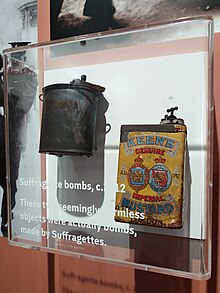
Back حملة التفجير والإحراق المتعمد التي شنتها ناشطات حق تصويت المرأة Arabic Campanya de bombardejos i incendis sufragistes Catalan ښځو ته د رایو د حق غوښتونکو بمي بریدونه او اور اچونې Pashto/Pushto Терроризм суфражисток Russian
| Suffragette bombing and arson campaign | |
|---|---|
 Two suffragette bombs, which were defused before they could detonate, on display at the City of London Police Museum in 2019 | |
| Type | Single-issue terrorism (§ classification as terrorism) |
| Location | United Kingdom (including Ireland) |
| Target | Government, infrastructure, churches, the public |
| Date | June 1912 – August 1914 |
| Executed by | Women's Social and Political Union (WSPU) |
| Outcome | Stalemate, outbreak of World War I halts campaign |
| Casualties |
|
Suffragettes in Great Britain and Ireland orchestrated a bombing and arson campaign between the years 1912 and 1914. The campaign was instigated by the Women's Social and Political Union (WSPU), and was a part of their wider campaign for women's suffrage. The campaign, led by key WSPU figures such as Emmeline Pankhurst, targeted infrastructure, government, churches and the general public, and saw the use of improvised explosive devices, arson, letter bombs, assassination attempts and other forms of direct action and violence.
At least four people were killed in the attacks, and at least 24 were injured (including two suffragettes). The campaign was halted at the outbreak of war in August 1914 without having brought about votes for women, as suffragettes pledged to pause the campaign to aid the war effort.
Both suffragettes and the authorities of the time described the arson and bomb attacks as a terrorist campaign. Contemporary press reports also referred to attacks as "terrorist" incidents in both the United Kingdom and in the United States. A number of historians have also classified the campaign as one involving terrorist acts, such as C. J. Bearman, Rachel Monaghan and feminist historians Fern Riddell and Cheryl Jorgensen-Earp.
| Part of a series on |
| Terrorism and political violence |
|---|